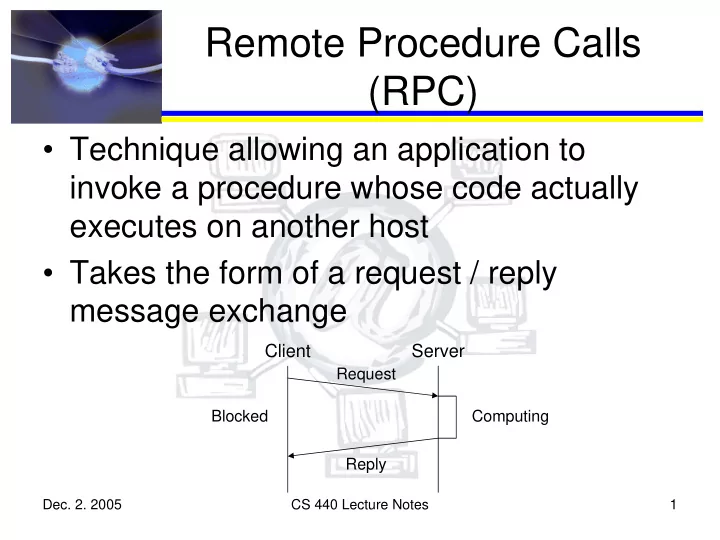

Remote Procedure Calls (RPC) • Technique allowing an application to invoke a procedure whose code actually executes on another host • Takes the form of a request / reply message exchange Client Server Request Blocked Computing Reply Dec. 2. 2005 CS 440 Lecture Notes 1
RPC (cont.) • Goal is to make process of calling a remote procedure indistinguishable from calling a local procedure to the client app • Difficulties – Network interaction introduces plenty of new complications that local call doesn’t have – Client and server hosts might have different architectures and different representations of data (i.e. big vs. little endian, 32-bit vs. 64-bit) Dec. 2. 2005 CS 440 Lecture Notes 2
RPC (cont.) • First problem solved by creating messaging protocol to mask network issues • Second problem solved by creating support to package arguments into requests and unpackage return values from responses – Machine specific – Maybe language specific – Called marshalling / demarshalling – Done by stub compiler Dec. 2. 2005 CS 440 Lecture Notes 3
RPC Network Protocol • Could run on top of TCP or UDP – TCP connection setup/teardown fairly wasteful to exchange a request and reply – UDP leaves several problems that protocol must address – mostly reliability • Might consider this as an alternative transport protocol, since it is working at the app-to-app level Dec. 2. 2005 CS 440 Lecture Notes 4
RPC Network Protocol (cont.) • Book introduces three-level microprotocol stack to accomplish different tasks – BLAST – handle message fragmentation • More efficient that IP – CHAN – synchronize messages – SELECT – dispatch requests to processes • Not standard protocols Dec. 2. 2005 CS 440 Lecture Notes 5
BLAST • Function similarly to IP fragmentation • Allows sender to acknowledge multiple fragments – Everything after a hole doesn’t need to be retransmitted • More aggressive in guaranteeing that all fragments are delivered • Not completely reliable Dec. 2. 2005 CS 440 Lecture Notes 6
CHAN • Adds reliability – Guarantees message delivery – Ensures only one copy of message delivered – Allows synchronization of client and server • Implements at-most-once semantics – Message might not get through at all – If it does, it won’t be delivered more than once – Essential for many remote procedures Dec. 2. 2005 CS 440 Lecture Notes 7
CHAN (cont.) • Synchronous protocol – client blocks while server is working, so only one call outstanding • Provides multiple channels – Possible to work around previous restriction by using parallel channels from one client to one server Dec. 2. 2005 CS 440 Lecture Notes 8
SELECT • Dispatcher that directs data from a message to correct procedure • Provides mechanism to identify application and procedure to call in that application • Manages multiple channels as necessary for parallel calls to server Dec. 2. 2005 CS 440 Lecture Notes 9
Real Implementation - SunRPC • Now called Open Network Computing RPC (ONC RPC) • Draft IETF standard • Standard on many Unix systems – May be most widely used RPC mechanism – Used by NFS Dec. 2. 2005 CS 440 Lecture Notes 10
SunRPC (cont.) • Implemented on top of UDP – Implements CHAN – IP used for BLAST (not as aggressive or efficient) – UDP provides dispatch to correct program, SunRPC selects correct procedure Dec. 2. 2005 CS 440 Lecture Notes 11
SunRPC (cont.) • Identifies program and procedure using two 32-bit numbers (program & procedure) • Uses PortMapper to map 32-bit program number to UDP port – Runs on well known UDP port (111) • Client caches port number – Avoids calling PortMapper for every procedure invocation Dec. 2. 2005 CS 440 Lecture Notes 12
SunRPC (cont.) • Does not guarantee at-most-once semantics – Possible for request to be delivered to server twice for some rare network conditions – Not addressed because protocol originally designed for use on a LAN, not an internet Dec. 2. 2005 CS 440 Lecture Notes 13
eXternal Data Representation (XDR) • Accompanying specification for mapping host data to message – Host architecture independent – Network independent • Described in RFC 1014 • Presentation layer protocol – Can be used independently of SunRPC Dec. 2. 2005 CS 440 Lecture Notes 14
OSF Distributed Computing Environment (DCE) • Can be used for stand-alone RPC – Use NDR stub compiler to generate language interface • Also used as foundation for Common Object Request Broker Architecture (CORBA) Dec. 2. 2005 CS 440 Lecture Notes 15
DCE (cont.) • Also implemented on UDP • Also uses “endpoint mapping service” to select correct UDP port • Implements fragmentation (like BLAST) • Implements at-most-once semantics – Can also support zero-or-more semantics Dec. 2. 2005 CS 440 Lecture Notes 16
Recommend
More recommend